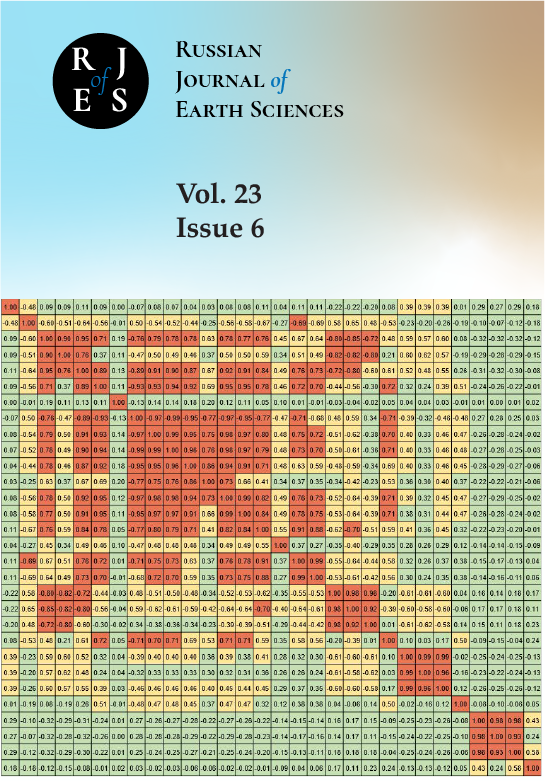с 01.01.2022 по 01.01.2023
Московский государственный университет имени М.В.Ломоносова
с 01.01.2019 по 01.01.2023
Москва, г. Москва и Московская область, Россия
УДК 53.05 Наблюдение и регистрация явлений. Наглядная демонстрация явлений
УДК 53 Физика
УДК 55 Геология. Геологические и геофизические науки
УДК 550.34 Сейсмология
УДК 550.383 Главное магнитное поле Земли
ГРНТИ 37.01 Общие вопросы геофизики
ГРНТИ 37.15 Геомагнетизм и высокие слои атмосферы
ГРНТИ 37.25 Океанология
ГРНТИ 37.31 Физика Земли
ГРНТИ 38.01 Общие вопросы геологии
ГРНТИ 36.00 ГЕОДЕЗИЯ. КАРТОГРАФИЯ
ГРНТИ 37.00 ГЕОФИЗИКА
ГРНТИ 38.00 ГЕОЛОГИЯ
ГРНТИ 39.00 ГЕОГРАФИЯ
ГРНТИ 52.00 ГОРНОЕ ДЕЛО
ОКСО 05.00.00 Науки о Земле
ББК 26 Науки о Земле
ТБК 63 Науки о Земле. Экология
BISAC SCI SCIENCE
Cтатья посвящена пространственному распределению средней продуктивности землетрясений основной части Японии за период 2000–2020 гг. Карты были построены с помощью инструмента The Generic Mapping Tools с использованием каталога Японского Метеорологического Агентства для землетрясений глубиной 40 км от поверхности. Речь идет о «коровых» землетрясениях сухопутной части Японии. Были построены карты для периода 2010–2020 гг., где варьировались радиус (25 км, 50 км, 100 км), полнота каталога (1 и 1,5) и ∆𝑀-продуктивность (1 и 2). Для самой показательной карты была проверена устойчивость картины во времени. Также сделана попытка проверить влияние теплового потока на распределение средней продуктивности землетрясений.
Закон продуктивности землетрясений, метод ближайшего соседа, тепловой поток, Япония
1. Baiesi M., Paczuski M. Scale-free networks of earthquakes and aftershocks // Physical Review E. — 2004. — Т. 69, № 6. — С. 066106. — DOI:https://doi.org/10.1103/PhysRevE.69.066106. EDN: https://elibrary.ru/WBXIIG
2. Cheng, Ch., Hui C., Yang J. и др. The relationship between heat flow and seismicity in global tectonically active zones // Open Geosciences. — 2020. — Т. 12, № 1. — С. 1430—1439. — DOI:https://doi.org/10.1515/geo-2020-0195.
3. Marsan D., Lenglin´e O. Extending Earthquakes’ Reach Through Cascading // Science. — 2008. — Т. 319, № 5866. — С. 1076—1079. — DOI:https://doi.org/10.1126/science.1148783. EDN: https://elibrary.ru/XXAAVU
4. Pisarenko V. F., Skorkina A. A., Rukavishnikova T. A. Application of New Statistical Methods to Estimation of the Seismicity Field Parameters by an Example of the Japan Region // Izvestiya, Physics of the Solid Earth. — 2023. — Т. 59, № 6. — С. 967—978. — DOI:https://doi.org/10.1134/S1069351323060162. EDN: https://elibrary.ru/GIXQNJ
5. Shebalin P., Baranov S., Vorobieva I. Earthquake Productivity Law in a Wide Magnitude Range // Frontiers in Earth Science. — 2022. — Т. 10. — DOI:https://doi.org/10.3389/feart.2022.881425. EDN: https://elibrary.ru/EKNRKP
6. Shebalin P. N., Narteau C., Baranov S. V. Earthquake productivity law // Geophysical Journal International. — 2020. — Т. 222, № 2. — С. 1264—1269. — DOI:https://doi.org/10.1093/gji/ggaa252. EDN: https://elibrary.ru/IHQXAK
7. Utsu T. Aftershocks and earthquake statistics (II): Further investigation of aftershocks and other earthquake sequences based on a new classification of earthquake sequences // Journal of the Faculty of Science, Hokkaido University. Series 7, Geophysics. — 1970. — Т. 3, № 4. — С. 197—266.
8. Vorobieva I. A., Gvishiani A. D., Shebalin P. N. и др. Integrated Earthquake Catalog II: The Western Sector of the Russian Arctic // Applied Sciences. — 2023. — Т. 13, № 12. — С. 7084. — DOI:https://doi.org/10.3390/app13127084. EDN: https://elibrary.ru/UFUMJT
9. Wessel P., Luis J. F., Uieda L. и др. The Generic Mapping Tools Version 6 // Geochemistry, Geophysics, Geosystems. — 2019. — Т. 20, № 11. — С. 5556—5564. — DOI:https://doi.org/10.1029/2019gc008515. EDN: https://elibrary.ru/JFOOHN
10. Zaliapin I., Ben-Zion Y. A global classification and characterization of earthquake clusters // Geophysical Journal International. — 2016. — Т. 207, № 1. — С. 608—634. — DOI:https://doi.org/10.1093/gji/ggw300.
11. Zaliapin I., Gabrielov A., Keilis-Borok V. и др. Clustering Analysis of Seismicity and Aftershock Identification // Physical Review Letters. — 2008. — Т. 101, № 1. — С. 018501. — DOI:https://doi.org/10.1103/PhysRevLett.101.018501. EDN: https://elibrary.ru/NGWIWD
12. Zhuang J., Ogata Y., Vere-Jones D. Stochastic Declustering of Space-Time Earthquake Occurrences // Journal of the American Statistical Association. — 2002. — Т. 97, № 458. — С. 369—380. — DOI:https://doi.org/10.1198/016214502760046925.














